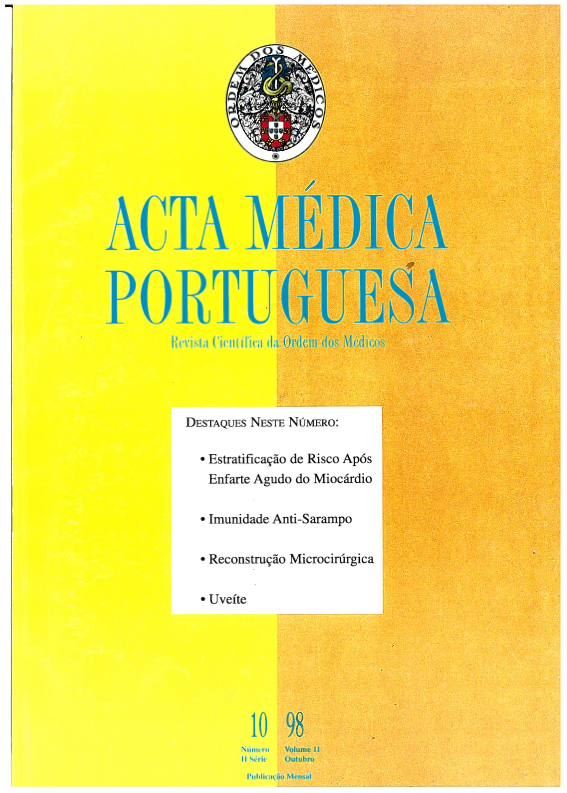Valor da prova de esforço na estratificação de risco após enfarte agudo do miocárdio.
DOI:
https://doi.org/10.20344/amp.2337Resumo
To assess the prognostic value of predischarge exercise testing (ET) in patients hospitalized for acute myocardial infarction (AMI).Department of Cardiology in a reference hospital for Interventional CardiologyBetween January 1990 and December 1994, 178 patients hospitalized for AMI were discharged and referred to the outpatient clinic (mean follow up, 1049 +/- 612 days). Eighty-two percent of these patients were men, mean age--56 +/- 12 years. Patients that did not perform predischarge ET (Group A, n 77) were retrospectively compared with those who did (Group B, n = 101). In relation to demographic and clinical characteristics; we analysed cardiac events (CE) and death during the first 18 months after discharge in both groups. In group B patients, we studied the relation of ET parameters (duration of exercise, occurrence of exercise-induced ischaemia and arrhythmias, maximum heart rate, blood pressure response, rate pressure product and severity score) to CE and death during the first 18 months after AMI.The proportion of patients aged 70 years or older was greater in group A (23% vs 3%, P < 0.001). In this group, there was a greater prevalence of recurrent ischaemia (51% vs 29%, P < 0.001) and left ventricular dysfunction (42% vs 25%, P < 0.05). Group A patients were also submitted to less thrombolysis (45% vs 62%, P < 0.05) and to revascularization procedures (25% vs 41%, P < 0.05). In group B patients, the incidence of CE did not differ with respect to duration of ET, rate pressure product or maximum heart rate. Incidence of CE was greater in patients with exercise-induced ischaemia (38% vs 15%, P < 0.05), severity score > 2 (45% vs 18%, P < 0.02) and inadequate rise (< 30 mmHg) in systolic blood pressure (39% vs 13%, P < 0.02). The total incidence of CE and revascularization was also greater in patients with exercise-induced ischaemia (88% vs 49%, P < 0.001), severity score > 2 (95% vs 56%, P < 0.02) and inadequate rise in systolic blood pressure (93% vs 45%, P < 0.001).In patients without indication for ET as part of risk stratification after AMI, clinical characteristics were more severe as defined by age greater than 70 years, residual ischaemia and left ventricular dysfunction. Patients that performed ET had smaller risk, except when presenting exercise-induced ischaemia, severity score > 2 and inadequate rise in systolic blood pressure.Downloads
Downloads
Como Citar
Edição
Secção
Licença
Todos os artigos publicados na AMP são de acesso aberto e cumprem os requisitos das agências de financiamento ou instituições académicas. Relativamente à utilização por terceiros a AMP rege-se pelos termos da licença Creative Commons ‘Atribuição – Uso Não-Comercial – (CC-BY-NC)’.
É da responsabilidade do autor obter permissão para reproduzir figuras, tabelas, etc., de outras publicações. Após a aceitação de um artigo, os autores serão convidados a preencher uma “Declaração de Responsabilidade Autoral e Partilha de Direitos de Autor “(http://www.actamedicaportuguesa.com/info/AMP-NormasPublicacao.pdf) e a “Declaração de Potenciais Conflitos de Interesse” (http://www.icmje.org/conflicts-of-interest) do ICMJE. Será enviado um e-mail ao autor correspondente, confirmando a receção do manuscrito.
Após a publicação, os autores ficam autorizados a disponibilizar os seus artigos em repositórios das suas instituições de origem, desde que mencionem sempre onde foram publicados e de acordo com a licença Creative Commons









